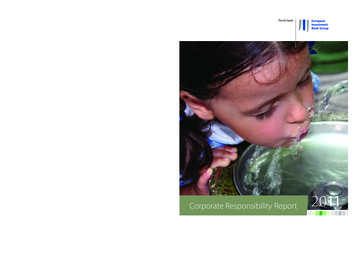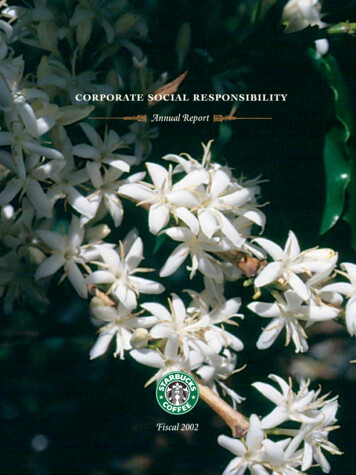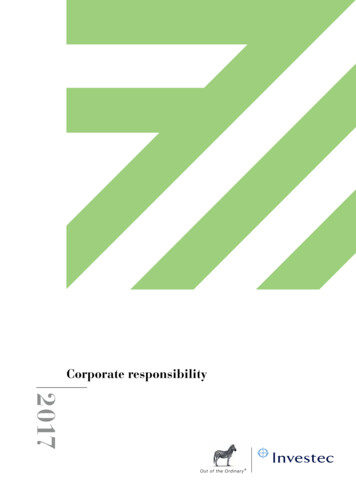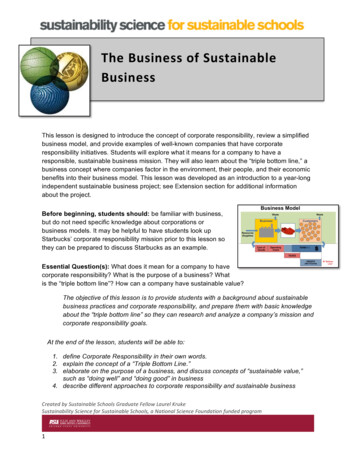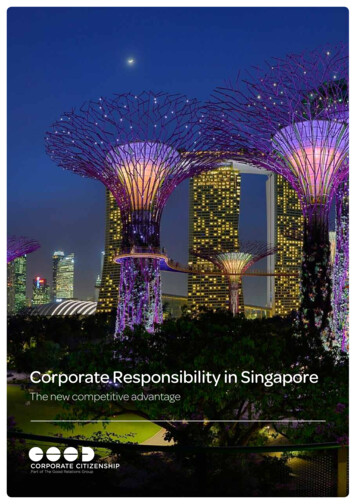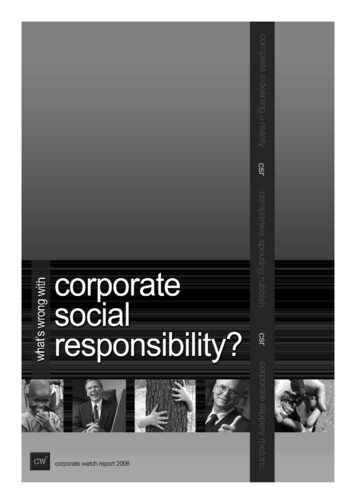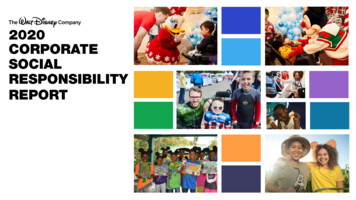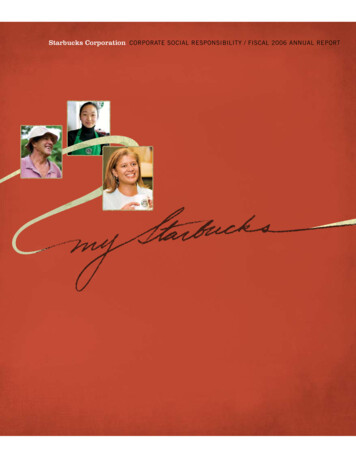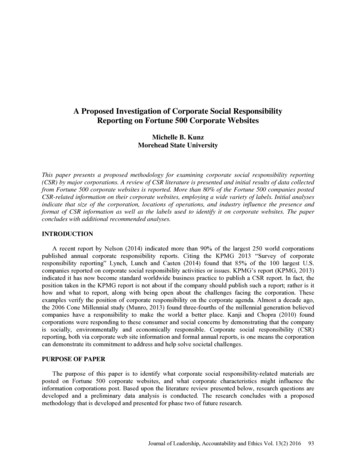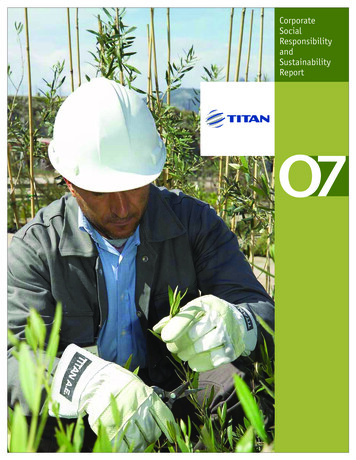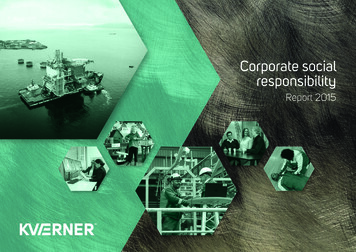
Transcription
Corporate socialresponsibilityReport 2015
KVAERNER CORPORATE RESPONSIBILITY REPORT 20153ContentsIntroduction 4About Kvaerner and CSR work 6Caring about our people 11Caring about HSSE 16Caring about business integrity 22Caring about the community 29About this report 30Company information 30
4KVAERNER CORPORATE RESPONSIBILITY REPORT 2015INTRODUCTIONIntroductionCorporate Social Responsibility (CSR) is an integrated part of the management responsibilitywithin Kvaerner. Our corporate goals and activities within CSR are anchored at the Board ofDirectors level and each business area is responsible for their implementation. The KvaernerCode of Conduct summarises our values and standards of behaviour in all types of activities,everywhere. It covers all areas within corporate social responsibility: human rights, prevention of corruption, employee rights, health, safety, security and the working environment, discrimination and natural environment, community-work and sponsorships.In our Code of Conduct and policies we describe how weshall run our business, including how we shall work withour partners, subcontractors and suppliers. New CSR keyperformance indicators are set every year with separatetargets for each operational area. Kvaerner is proactivelyrecognising and managing risks to achieve our CSR targets.We work closely with our customers and suppliers toachieve our goals and understand risks and to optimise theway we deliver our projectsKvaerner's ambitions within HSSE are not only part ofthe company’s core values, but are regarded as our licenceto operate. We continuously strive to achieve our goal ofzero harm to people, the environment, property and nonmaterial assets, and we work systematically to improve ourHSSE culture and performance. Despite our HSSE efforts, weexperienced a tragic fatality in March 2015 where we lostone of our colleagues at the Draugen decommissioning project. Any accident is unacceptable and should not happen inKvaerner. Our independent investigation team identifiedthe main causes for the accident. They also defined a number of recommendations that were put into action in orderto strengthen our clear safety rules and HSSE performancein all phases of Kvaerner’s operations.In 2015, Kvaerner had high activity in our operationsand all projects were progressing as planned. In April, the22 000 tonnes topside for the new offshore platform forthe Edvard Grieg field was ready for delivery, as agreedwith Lundin three years earlier. The Nyhamna project forShell completed several milestones, the largest being a 40day successful turn-around. In Newfoundland, Kvaerner isconstructing the Hebron gravity based structure for ExxonMobil together with Kiewit. We continue to focus on delivering projects with safe execution, predictable schedule andagreed quality. During 2015 Kvaerner signed several contracts with Statoil for the Johan Sverdrup field development, confirming our position as a leading contractor withinthe oil and gas industry.During the year, Kvaerner continued its work on international business opportunities, some of these in Russia withhigh inherent corruption risks. It is acknowledged by alllevels of management in Kvaerner, that doing business incountries like Russia requires us to give special attention toissues of Compliance and have a high focus on risk assessment and implementing effective proactive risk reducingactions.In our Code of Conduct it we state that Kvaerner commits to monitor the performance of our suppliers and subcontractors and will take immediate and relevant remedialsteps in cases where the ethical performance of its businesspartners comes into question. During 2015 Kvaerner extended its integrity due diligence work and executed several audits among our suppliers, in particular in the area oflabour conditions which lead to several improvement actions being implemented by the suppliers.In 2016 we will continue to strengthen the proactive focus on new opportunities and continuous improvementswithin CSR. We believe this is the basis for conducting ourbusiness in a way that makes people proud to work with,and for, our company.Jan Arve HauganPresident & CEO
INTRODUCTIONKVAERNER CORPORATE RESPONSIBILITY REPORT 20155
6KVAERNER CORPORATE RESPONSIBILITY REPORT 2015ABOUT KVÆRNERAbout Kvaerner and CSR workKvaerner is headquartered in Oslo, Norway, and has offices and fabrication facilities in some of theworld’s main oil and gas regions. The company is a leading provider of engineering, procurementand construction(EPC) services, and delivers offshore installations and onshore plants for upstreamoil and gas production around the world.Our people, portfolio and major project executionactivities in 2015The Kvaerner organisation includes specialised fabricationyards and offices for engineering and procurement in Norway, Canada, UK, USA, Russia, Finland and China. A typicalproject involves several hundred first line suppliers.Kvaerner uses many large subcontractors; several of theseare located in Poland.We planand executedemandingEPC projectsKvaerner was in 2015 organized into four different business areas. As of 31 December 2015, the total Kvaernerworkforce comprised 3 262 individuals, including 2 811permanent employees and 451 contract staff. (For moreinformation – see chapter Caring about our People).Globally, the oil and gas industry is faced with reducedmarkets and all companies are taking actions with both significant and lasting effects. It will be fundamental forKvaerner’s ability to continue to be successful and win newprojects that we also continue to improve our productivityand reduce our cost base. From 1 January 2016, Kvaernerchanged to a matrix based organisation model with enhanced focus on project execution. The business area structure was removed and the revised operating model will provide clearer roles and accountabilities. The aim is to increaseproductivity through better internal cooperation and use ofcommon resources. Simultaneously, cost savings can be enabled by fewer man-hours spent on internal processes.Major project execution activities in 2015Kvaerner’s workload in 2015 consisted of several largeprojects with different customers:THE EDVARD GRIEG PROJECTIn April 2015 the 22 000 tonnes topside for the new offshore platform for the Edvard Grieg field was ready for delivery, in line with the contract awarded three years earlier.Lundin Norway is the operator of the field and ordered thetopside as a complete EPC delivery from Kvaerner in 2012.In addition to delivering the topside as agreed, the projectalso had a high share of work performed in Norway. TheNorwegian value creation from both Kvaerner and subcontractors totals around 70 percent of the delivery. In November 2015 Lundin announced that the new Edvard Griegoffshore platform on the Norwegian continental shelf hadstarted production as scheduled. The project has providedsignificant positive effects for both more than 150 suppliers and the communities where they are based. At peak,the project involved more than 7 500 personnel.
KVAERNER CORPORATE RESPONSIBILITY REPORT 2015ABOUT KVÆRNERTHE NYHAMNA PROJECTKvaerner was the main contractor for the initial development of the Nyhamna onshore gas treatment facility, andwas in April 2012 awarded a frame agreement for modifications and projects at the Nyhamna/Ormen Lange onshorefacilities the Nyhamna Expansion project. The Nyhamna gasplant processes natural gas from the Ormen Lange gas fieldlocated in the southern part of the Norwegian Sea. The contract scope includes all modifications and projects on theOrmen Lange/Nyhamna facility and is established to meetthe expected, significant increased project activity over thenext five to ten years. A major milestone was reached onthe project in June 2015 when the complex turnaround ofthe hot plant was successfully completed in 40 days. Thiswas achieved due to both excellent planning and executionin close cooperation with all involved parties.THE HEBRON PROJECTIn March 2013 ExxonMobil Canada Properties released theoption for Kvaerner's joint venture company KiewitKvaerner Contractors to provide the full scope of engineering, procurement and construction (EPC) services for theHebron gravity based structure (GBS). This will be the second largest GBS ever constructed. The Hebron oil field islocated offshore Newfoundland and Labrador in the Jeanned'Arc Basin southeast of St. John's. The construction activities at the Bull Arm deep water site in Newfoundland continue in 2016. The latest slip form operation, the CentreShaft was successfully completed in December 2015 asscheduled. Mechanical outfitting activities in in the centreshaft is also ongoing.The project now stands at more than19 million man-hours without a lost time incident.7JOHAN SVERDRUP PROJECTSKvaerner will be delivering the three largest of the foursteel jacket substructures for Johan Sverdrup, in additionto one of the utility and living quarters (ULQ) platform topsides. The steel jackets will be delivered in the spring of2017 and summer of 2018. The ULQ-platform is one offour platforms to the Phase One development of the JohanSverdrup oil and gas field on the Norwegian continentalshelf. The Kvaerner-KBR joint venture will execute the engineering, procurement and construction (EPC) for the ULQtopside as one complete delivery. The agreement also includes an option for commissioning assistance and offshore hook-up for the platform.
8KVAERNER CORPORATE RESPONSIBILITY REPORT 2015ABOUT KVÆRNER"Our corporate goals and activities within CSR are anchored at the Board of Directorlevel and each business area is responsible for their implementation"Studies and business development activitiesIn December 2015, Statoil awarded Kvaerner, as one of twosuppliers, a study contract for concept development of fourseparate unmanned platforms, the new Kvaerner “UnmannedWellhead Platform/Subsea on a Stick ” product for phase 2 ofthe Johan Sverdrup field. The work will be performed by theKvaerner engineering offices in Verdal, Trondheim and Oslo.Kvaerner is also exploring business opportunities internationally. Kvaerner has during 2015 worked on severalpre-study projects in Russia. Kvaerner has strong experience from previous large projects in Russia – the Sakhalin2 and Sakhalin 1 projects. It is acknowledged by all levelsof management in Kvaerner, that doing business in countries like Russia requires us to give special attention to issues of Compliance. In 2014, several countries, includingthe United States, European Union and Norway introducedrestrictions on certain dealings with Russia and with selected Ukrainian and Russian nationals and companies.Kvaerner is closely monitoring this and maintains a dialogue with the Ministry of Foreign Affairs in Norway onthe development. During 2015, there have been signs onpotential upcoming lifting of the Iran sanctions. Kvaernermonitors project opportunities and will evaluate how thecompany can offer value adding solutions if relevant prospects should arise.In chapter 4 we describe the particular risks for Kvaerner within business integrity and how we manage these.Our Corporate Social Responsibility standardsCSR is an integrated part of the management responsibilitywithin Kvaerner. Our corporate goals and activities withinCSR are anchored at the Board of Director level and eachbusiness area is responsible for their implementation.The Code of Conduct available at the Kvaerner externalwebsite ner-Code-of-Conduct/summarises the group’s valuesand standards of behaviour in all types of activities, everywhere. It covers all areas within corporate social responsibility: human rights, prevention of corruption, employeerights, health, safety, security and the working environment,discrimination and natural environment, community-workand sponsorships. Kvaerner is a significant part of some ofthe societies in which we operate, both locally and globally.Kvaerner has several Joint Venture Partners around theworld. All entities where Kvaerner has more than 50 percent ownership are considered part of the Kvaerner groupand shall be operated in accordance with Kvaerner Policies.In joint ventures or subsidiaries where Kværner ASA directly or indirectly controls 50 percent or less of the voting interest, Kvaerner shall ensure that the main principles ofthis policy are incorporated in the governing documents ofthe subsidiary or joint venture.A typical Kvaerner project involves 300 first line suppliers. In the Kvaerner Code of Conduct Kvaerner commitsto monitoring the performance of its suppliers and subcontractors and will take immediate and relevant remedialsteps in cases where the ethical performance of its businesspartners comes into question.Kvaerner has a very restrictive policy when it comes tothe use of third party representatives. All are required tocomplete an Integrity Due Diligence process and get finalapproval from Corporate VP Compliance, SVP Legal andPresident & CEO.The People Policy sets out Kvaerner’s fundamental principles for ensuring the ability to attract, engage and retain aworkforce with the right skills, attitudes and behaviour.With several thousands of employees around the world,representing many cultures, religions and ethnic groups,Kvaerner’s focus is to help each employee realise his or herpotential and to look after his or her own and other’shealth and safety. Kvaerner efforts are guided by a commitment to protect the human rights (including labours rights)of the employees, contract staff as well as our partner, subcontractor and supplier staff.The Business Integrity Policy which is available at Kvaerner’s external website under the Code of Conduct y/KvaernerCode-of-Conduct/covers human rights, corruption and improper payments and fraud. The company shall conduct itsbusiness in accordance with the fundamental human rightsstated in the United Nations Universal Declaration of HumanRights (1948) which defines a number of fundamental principles on religious, political, cultural, economic and socialrights. Business integrity extends beyond legal complianceand Kvaerner aims to conduct its business in a manner thatmakes people proud of working with and for the company.The Health, Safety, Security and Environment (HSSE) Policysets out Kvaerner’s fundamental principles within thesefour areas. Kvaerner focus on employee health and on continuously improving the work environment. Kvaerner employees are entitled to a workplace which is safe and secure. Kvaerner has a zero incident mind-set, meaning thatthe target is zero personal injuries and zero cases of workrelated illness. Kvaerner continuously works to reduce theenvironmental footprint of its operations and products andthe methodology for reporting environmental impact derives from the Greenhouse Gas Protocol – GHG, and GlobalReporting Initiative – GRI. Moreover, the Norwegian yardsare certified according to the ISO 14001 environmentalstandard. Due to the global nature of Kvaerner’s operations,the company is exposed to changes in the global securityrisk situation. Kvaerner has a separate procedure in placefor Corporate emergency response.The Kvaerner Supply Management Policy describes thesupplier qualification system, which is mandatory when engaging suppliers and subcontractors. The Kvaerner supplier
ABOUT KVÆRNERand subcontractor declaration describes the conductthat suppliers have to comply with. As part of thepre-qualification process, all suppliers and subcontractors have to sign the Kvaerner supplierDeclaration and complete the qualificationquestionnaire which contains a range ofquestions within the different CSR areas.Reporting concerns – whistleblowing:Kvaerner employees have many waysof addressing concerns. Kvaerneremployees are encouraged, whenever possible and feasible, toraise questions and report issues to their line managers andrepresentatives of senior management. Any allegation of potential violation of the Kvaerner compliance policies can also be reportedconfidentially or anonymously to theCorporate Compliance function via thewhistleblowing channel available at theKvaerner external website www.kvaerner.com and through the Kvaerner intranet. Statistics for 2013, 2014 and 2015 are included inchapter four.Opportunities and risksInput from the Board of Directors and ourowners, the Executive management representing each operational unit as well as ourcustomers are taken into account to identify and priorities material business andthe strategy for these.In 2014 Kvaerner performed anin-depth People Survey which con-9
ABOUT KVÆRNER"Kvaerner has a zero tolerance for corruption and will only work withlocal partners and suppliers who have the same policy"tained several CSR related questions. Thenext People Survey will be performed in2016. CSR is on the agenda in regularmeetings with the Executive Management as well as with the Board of Directors. Kvaerner performs an Annual strategy session with the Boardof Directors which includes alsoan annual risk review withineach CSR area with respect tothe CSR targets.Kvaerner relies on ourreputation as a top performer within CSR bothto attract new employees and to retain ouremployees. A solid CSRperformance and focus oncontinuous improvement represent also an opportunity tocontribute to the sustainable development of the communitieswhere we operate. In all Kvaernerprojects we seek to employ and trainlocal staff. On a typical Kvaerner project we use a large portion of hired-insand typically more than 300 first linesuppliers. Kvaerner believes that by improving our focus in particular on human rights and labour conditions inthe supply chain we will strengthen our supplier relationships andthat this also will increase theproject efficiency (see more inchapter 2, 4 and 5).The Kvaerner projectsare characterized by alarge portion of construction work with inherent high safetyrisks. Kvaerner had one fatal incident in 2015 and severalnear-misses with four red incidents. In 2011 one employeelost his life after a fall-incident on the Sakhalin-project inRussia. At Stord, one person died 10 years ago at the Kristin-project. Focus on reducing risks within safety is the number one priority for Kvaerner in all our activities. In the Annual risk review with Board of Directors for 2015 our abilityto deliver a consistent and continuous HSSE performancewas on the Top 5 list of the Company risks (see more inchapter 3).For many years, Kvaerner has chosen to operate incountries with high inherent corruption risks, such as Russia and Kazakhstan. The ministry of trade in Norway expects Norwegian companies to be leading in CSR. It is wellunderstood by all level of management that the compliancerisks in these countries are high and that operating in thesecountries require a very high focus on preventive compliance actions. In the Annual risk review with Board of Directors for 2015 risks within our business development activities in Russia and Iran was ranked as the number one riskarea within business integrity (see more in chapter 4).Kvaerner continuously works to reduce the environmental footprint of Kvaerner’s operations and products. In ourSupplier Declaration, which all suppliers to Kvaerner has tosign in order to be pre-qualified, the suppliers commit towork to minimise negative impacts on the environment,taking into consideration the full life cycle of their products.Kvaerner continuously work to improve the follow-up ofour suppliers in this area (see more in chapter 3).New CSR key performance indicators are set every yearwith separate targets for each operational area. This reportcontains in the end of each chapter the Key PerformanceIndicators used in 2015 within the specific area with theachieved result.
KVAERNER CORPORATE RESPONSIBILITY REPORT 2015CARING ABOUT OUR PEOPLE11Caring about our peopleA competent and motivated workforce, striving toward the same goals, is vital to Kvaerner’s success. All major achievements are the results of team efforts. In the end, our results are dependenton the skills and motivation of our employees and contract staff. During 2015 a separate projectwas established to work on a more efficient organisation model.OrganisationThe downturn in the oil- and gas industry had some effecton Kvaerner’s workforce. Fluctuating workload at the Stordand Verdal yards has caused periods of temporary leave forsome categories of employees and has further caused a significant reduction in use of temporary personnel. To furtherimprove competitiveness, Kvaerner changed to a matrixbased organisation model from 1 January 2016 with enhanced focus on project execution. The current businessarea structure was removed and the revised operatingmodel will provide clearer roles and accountabilities. Theaim is to increase productivity through better internal cooperation and use of common resources. Simultaneously,cost savings can be enabled by fewer man-hours spent oninternal processes.Improvement goals from People survey 2014deliveredIn 2015, Kvaerner’s organisation focused on delivering theimprovement goals which were defined and concluded afterthe People Survey 2014. The status of the improvementwork has been thoroughly followed-up with bi-monthly reporting. Regular status update has been provided to theemployees. Approximately 80 percent of the improvementactions from the 2014 People Survey have been completedthrough 2015.Internal communication, leadership and business integrity was the top three prioritised areas as a result of the People survey. Kvaerner’s business areas have improved thecommunication content on strategy and provided the strat-egy information on regular basis to the employees. In orderto strengthen leadership performance, adequate leadershiptraining has been provided. The use of performance dialogues has been revitalised, and completion of the dialogues has been highly prioritised and followed-up. Withinthe field of business integrity, training and information onreporting concerns on censurable conditions has been provided. Furthermore, Kvaerner has strongly focused onavoiding any form of discrimination, harassment and bullying by providing appropriate training of employees andmanagers. In this regard, 70 percent of Kvaerner’s employees have completed eLearning course on discrimination,harassment and bullying through 2014 and 2015.Diversity and equal opportunitiesAs the nature of Kvaerner’s operations calls for employeesfrom different operating entities and geographical regionsnationally and internationally, the principles of equal opportunity are (well) established throughout the group. Nodifferences shall exist based on genders, nationalities orethnic groups. Our commitment is clearly outlined in theCode of Conduct, the Business Integrity Policy, People Policy and in the Global Framework Agreement for the development of good working relations, a three-party frameagreement with national and international trade unions.The agreement describes Kvaerner’s commitment to respect human and trade union/labour rights, acknowledgingthe fundamental principles of human rights with a specificfocus on non-discrimination. Kvaerner aims to hinder anyform of discrimination, harassment or bullying (see alsochapter four on Caring about integrity) through equal opportunity training with employees.Due to fluctuating workload, temporary personnel fromabroad have been engaged for periods in Kvaerner’s yards.The work for improving the cultural competence andawareness among leaders and employees, together withinformation in all relevant languages and well working welfare have been continued from 2014 offerings to securegood integration of the personnel.Equal opportunity for both genders is a basic principle inKvaerner, evidenced in recruitment and appointments tomanagement positions employment conditions, compensation and training policies. Kvaerner still need to improvewithin this area. Currently, women account for 15 percentof Kvaerner’s workforce, same as in 2014. Some 20 percentof senior Kvaerner managers compared to 16 percent in2014. As of 31 December 2015 one of the company’s fourshareholder-elected Director positions- are held by women,whereas two women left the Board of Directors during2015. In the course of 2014 and 2015 there has been limited recruitment of new employees and the recruitmentbase for the actual vacancies have consisted of less womenthan men. In 2015 26 percent of women in senior management positions completed company leadership development training programmes compared to four percent in2014. Leadership training is vital in increasing the numberof females promoted to managerial positions. Employmentconditions and compensation packages are based on responsibility and personal performance, irrespective of gender.Due to the market situation, recruitment of new employees has been limited in 2015. Kvaerner’s equal opportunityprinciples are consistently applied when evaluating individuals either for recruitment from external or for appointment to management positions.
CARING ABOUT OUR PEOPLE"Kvaerner seeks to motivate young people through apprenticeships at its yardsand works consistently with technology students at the universities"Recruitment and retentionKvaerner is focused on the retention of an experiencedworkforce and the employment of apprentices. Kvaerner recruited 45 new employees in 2015 compared to 228 newemployees in 2014. About 20 percent of these were below30 years of age compared to 43.5 percent in 2014, 30 percent were above 50 years compared to 13 percent in 2014.The total voluntary employee turnover was 3 percent in2015 compared to 4 percent in 2014.Despite the fluctuating market conditions in the oil- andgas industry, it is crucial for Kvaerner to retain core competencies and develop new competencies. The company offersan inspiring and challenging work place, with a high degreeof teamwork and good individual career and developmentopportunities.Kvaerner depends on the constant convergence of skilledoperators, thus maintaining high level of core knowledgeand experience at its two yards, Stord and Verdal. Kvaerner’s continuous focus on recruiting new apprentices is keyto replenishing major yard positions and professional competence. At year end 2015, there were 121 apprentices atthe Stord and Verdal yards in total compared to 172 apprentices in 2014. Kvaerner seeks to motivate young people through apprenticeships at its yards. FurthermoreKvaerner works consistently with technology students atthe universities. Kvaerner continues to develop its relationships with relevant vendors of contract employees in orderto secure the availability of this workforce during peak project activity.In 2016 it is planned to recruit 31 new apprentices. Dueto the market situation, the general recruitment of new employees in 2016 will be limited to replacements.Learning and developmentTo execute some of the industry’s most demanding projects,Kvaerner must retain and develop talented and motivatedemployees who understand our customers’ needs and requirements. Safe and high quality operations for customers,employees, shareholders and other stakeholders are madepossible through a strong focus on continuous project management education and the practical training of leaders,employees and teams at all levels. All training is based onthe company’s core values, the Code of Conduct and theleadership principles. HSSE is one of Kvaerner’s core valuesand central to all training activities (see also chapter 3).Developing project management competence and awareness: Outstanding project management is a crucial successfactor for Kvaerner. To maintain and upgrade formal projectmanagement qualification, Kvaerner provides post-qualifying education and certification for selected managers inprojects. From 2012 to the end of 2015, Kvaerner has developed 47 certified leaders spread across all InternationalProject Management Association (IPMA) competence levels.The majority of the certified leaders are on the ‘C’ (projectmanager) and B (senior project manager) competence levels.The certification process ensures a focus on project management planning and control.Utilising awareness and knowledge: All project deliveriesreflect collaborative team efforts. The Project ExecutionModel (PEM) is, together with highly skilled and fullyaligned project teams, a key to success. The Training Centretrains project management teams in the practical application of PEM through predefined workshops. The workshopshave participation from both representatives of our Executive Management Team and the Project Management teamswhere alignment is the key focus.Leadership training and development: The LeadershipTraining programme (KLT), established in 2011, providespractical leadership training for first time and first linemanagers. This is the basic programme for leadership inKvaerner. The majority of the participants will take on leader positions in projects. The Leadership Alignment Programme model (LeAP) has been developed with the pur-pose of securing that Kvaerner’s values and leadershipprinciples are applied in all projects.The programme is applied both internally and together with our customers andsubcontractors.Educational pathway programmes: In order to secure aconsistent inflow of engineering competencies, the company, through its Business areas, has implemented educational pathway programmes to help motivated, qualified, andskilled Kvaerner workers and operators complete engineering degrees. The pathway consists of three steps: TechnicalCollege, University College and University. The aim is to increase the number of practical engineers able to preparefor, follow-up and manage construction activities. The twoyear formal technical study coincides with ordinary work.Workers/students are placed in a fixed rotation – twoweeks work and one week study – and complete the st
In March 2013 ExxonMobil Canada Properties released the option for Kvaerner's joint venture company Kiewit-Kvaerner Contractors to provide the full scope of engineer-ing, procurement and construction (EPC) services for the Hebron gravity based structure (GBS). This will be the sec-ond largest GBS ever constructed. The Hebron oil field is
